The Lysikrates Choregic (Choragic) Monument was established in 334-333 B.C. in the ancient Street of the Tripods which connected the ancient Agora with the Sanctuary and the Theater of Dionysos. The tripods were the prizes awarded to the 'Choregoi' (Sponsors) by the city for their victory in the dramatic contests of the Great or 'En Astei' (in the city) Dionyssia. During the 5th century BC they were set up on rectangular bases, while in the 4th cent. BC they stood on more elaborate buildings, usually resembling temples. The "choregoi" were the sponsors who paid for and supervised the training of the dramatic dance-chorus and used to set up such constructions in the Street of the Tripods to share their glory with the citizens of Athens, as it was unthinkable to keep such prizes at home. Pausanias tells us that the small, temple-like choregic monuments in this street were numerous, a fact that was proved during excavation works around the Acropolis Rock, but this monument is the only one surviving and in a very good condition. We know the time of its erection thanks to a mention of Evainetos in the choregic inscription, ruling 'archon' of Athens from 334 to 333 B.C. The whole inscription is as follows: "Lysicrates, son of Lysitheos, from Kikineus, was a choregos; the Acamantide tribe won the prize of the chorus of boys; Theon was a flute player; Lysiades the Athenian was the teacher of the chorus; Evainetos was the Archon"
The Lysikrates Choregic Monument was traditionally called the Lantern of Diogenes (and it is still called this way by the Athenians), for unknown reasons. It is a circular building in the shape of a peripteral tholos supported by six Corinthian columns of Pentelic marble alternating with panels of Hymettian marble; the whole construction stands on a square podium of poros stone. It has a marble frieze depicting the adventure of Dionysos with the pirates, whom he turned into dolphins. The construction was topped by the choregic tripod, not preserved today. In 1660 the monument and its surrounding area were incorporated into the Capuchin Monastery, where Lord Byron, Chateaubriand and others were later entertained. With the exception of the Lysicrates Monument, all the buildings of the monastery were destroyed in 1824 by Omer Pasha.
In 1845 French archaeologists cleared the monument and the area around it from the debris and found some missing parts of it which were encorporated to the monument during works by F. Boulanger and E. Loviot (1876-1887).
(Photos by Michael Tziotis)
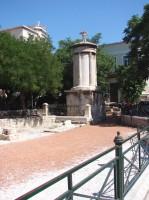
The Lysicrates Choregic Monument
The sand and gravel in the foreground covers the excavation site around the monument after it was photographed and studied. Finds included remnants of the ancient Tripods street and foundations of buildings dug into the earth-fills covering bases of more choregic monuments and Christian tombs. |
|
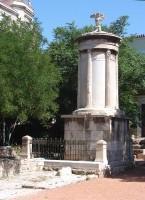
The Lysicrates Choregic Monument |
|
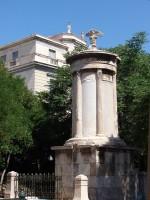
The Lysicrates Choregic Monument |
|
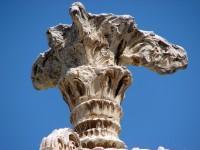
The Lysicrates Choregic Monument
The crowning the monument base of the now missing Lysicrates choregic tripod. |
|
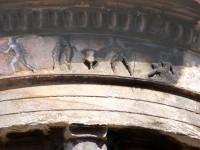
The Lysicrates Choregic Monument
Part of the marble frieze depicting the adventure of Dionysos with the pirates. |
|
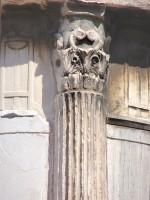
The Lysicrates Choregic Monument
Top of one of the columns, of Ionic order; the monument is one of the first buildings in Athens to make use of columns of this order. |
|

The Lysicrates Choregic Monument |
|
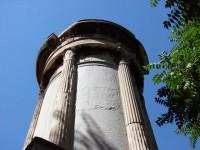
Plaka: The Lysicrates Choregic Monument |
|
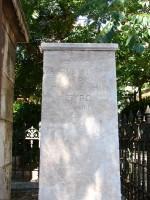
The Lysicrates Choregic Monument
A column commemorating the fact that the monument had been part of the Capuchin Monastery where Lord Byron once stayed. |
|
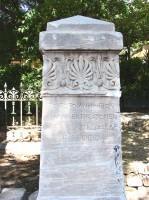
The Lysicrates Choregic Monument
Another column informing the visitor that the monument had been bought and renovated by France. |
|
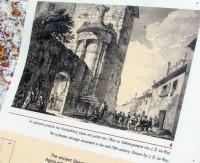
The Lysicrates Choregic Monument
Photo of a drawing of the monument and the adjacent buildings in the middle of the 18th century |
|
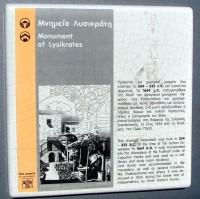
The Lysicrates Choregic Monument
Photo of an informative sign in the spot |
|
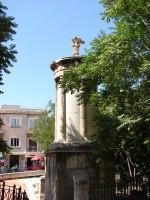
The Lysicrates Choregic Monument |
|
|



